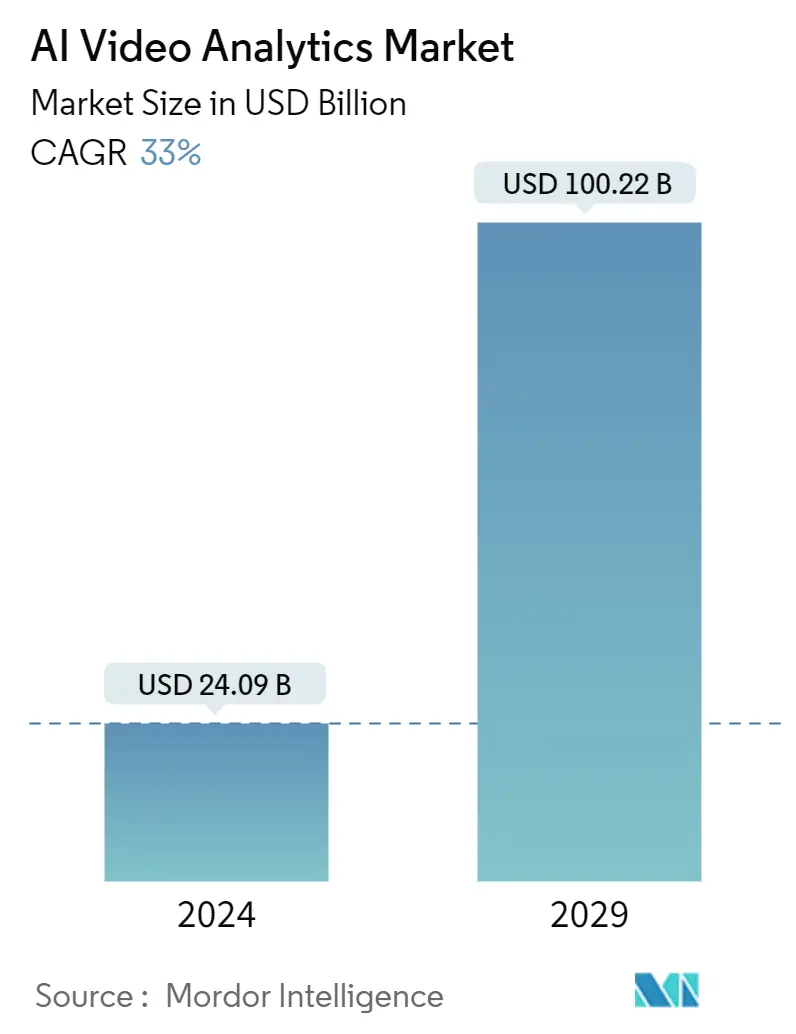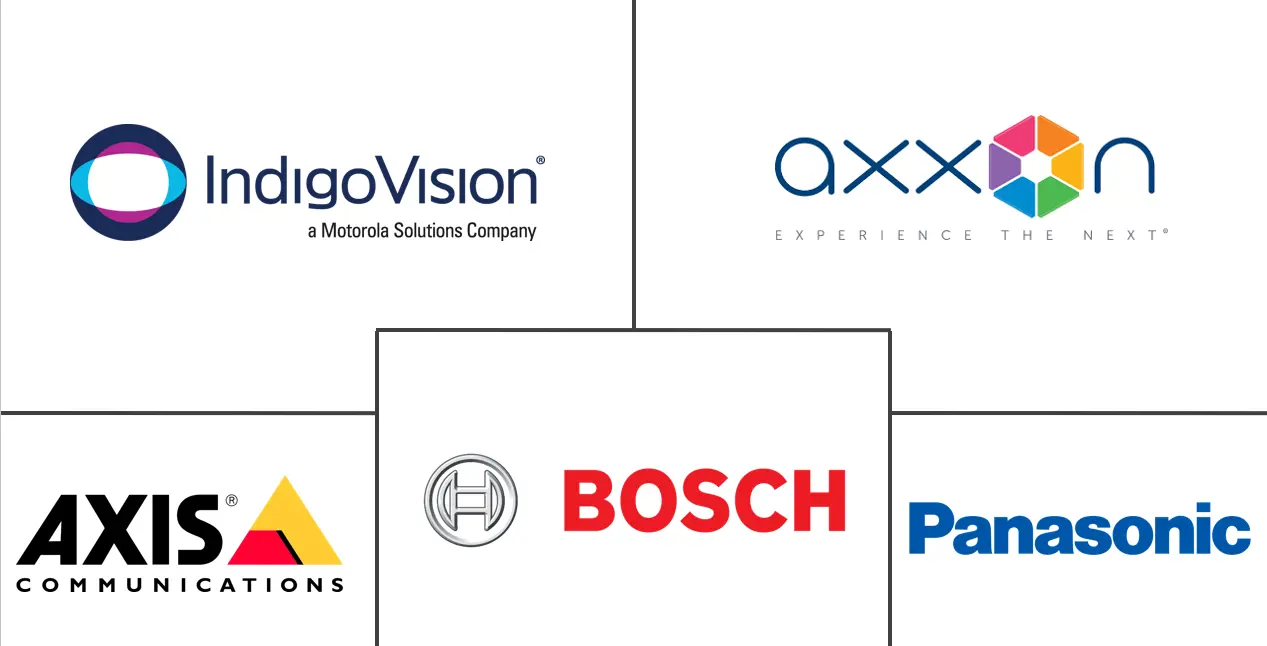Market Size of AI Video Analytics Industry

| Study Period | 2019 - 2029 |
| Market Size (2024) | USD 24.09 Billion |
| Market Size (2029) | USD 100.22 Billion |
| CAGR (2024 - 2029) | 33.00 % |
| Fastest Growing Market | Asia-Pacific |
| Largest Market | North America |
Major Players
*Disclaimer: Major Players sorted in no particular order |
AI Video Analytics Market Analysis
The AI Video Analytics Market size is estimated at USD 24.09 billion in 2024, and is expected to reach USD 100.22 billion by 2029, growing at a CAGR of 33% during the forecast period (2024-2029).
The governments of numerous countries are rapidly using AI-based video analytic systems for traffic monitoring and in public infrastructures to improve residents' security and safety. The growing use of video surveillance in commercial buildings such as malls, airports, railway stations, ports, and so on, as well as residential structures, has boosted the demand for visual analytics.
- The advancements in intelligent software have outpaced traditional monitoring techniques. The sophisticated surveillance systems can be used in the provided area and have widespread self-learning capabilities. Al can watch the security cameras round-the-clock. Additionally, it can offer in-the-moment analysis, map, track, control shady movement, and save lives. To give the general public a safe environment, the governments of numerous nations are putting surveillance infrastructure in place. Al's potential for usage in healthcare software and smart homes could also spur market growth for video analytics. These factors could all have an impact on Al's growth in the market for video analytics.
- AI video analytics is becoming an increasingly important tool for the defense industry, with many companies and government agencies exploring its potential to enhance security and protect against threats. There are numerous use cases for AI video analytics in defense, ranging from facial recognition for threat detection to object recognition for identifying potential targets. Some leading innovators in AI video analytics for defense include IronYun, Avigilon, and IntelliVision. The United States Department of Defense CTTSO awarded IronYun a contract for its highly accurate, AI-enabled video analytics.
- Artificial Intelligence (AI) video analytics is transforming the transportation industry by providing insights into traffic patterns and identifying potential safety hazards. Video analytics can be used for various applications, including traffic flow optimization, monitoring vehicle emissions, and detecting parking violations. One of the most promising applications for AI video analytics in transportation is monitoring public transportation systems to improve safety and security. Transport for New South Wales has partnered with AI companies to build a public safety system using video analytics to monitor and analyze data to identify potential safety issues and respond more quickly to incidents.
- Conversely, managing and storing the data can be challenging, with increasing amounts of data collected from video analysis tools and cameras. This requires great storage space and strategies that allow for easy and efficient data retrieval from large databases. Video analytics tools are complex and require skilled personnel to operate and maintain. This can challenge businesses without the resources to attract and retain highly skilled workers.
- The COVID-19 pandemic significantly impacted the world, including the field of video analytics. Here are some ways that AI-powered video analytics were affected by COVID-19; increased demand for AI-powered video analytics: As companies and governments look for ways to maintain public health and safety in the face of COVID-19, there was an increased demand for video analytics solutions that helped enforce social distancing, monitor mask compliance, and perform other tasks related to COVID-19 prevention.
AI Video Analytics Industry Segmentation
Artificial intelligence for video analytics and surveillance leverages AI and ML algorithms that analyze the audio and images from video surveillance cameras to recognize humans, vehicles, objects, attributes, and events. This represents a sub-set of Video Analytics where AI-based capabilities are leveraged for implementing edge & centralized use cases.
The global AI Video Analytics Market is Segmented by End Users (Retail, Government, and Defense (including public safety), Critical Infrastructure, Transportation, Healthcare, and Consumers), and Geography (North America, Europe, Asia Pacific, Latin America, Middle East, and Africa).
The market sizes and forecasts are provided in terms of value (USD) for all the above segments.
| By End-User | |
| Retail | |
| Government and Defense (includes public safety) | |
| Critical Infrastructure | |
| Transportation | |
| Healthcare | |
| Consumers | |
| Other End-Users (Education and Hospitality) |
| By Region | |
| North America | |
| Europe | |
| Asia-Pacific | |
| Latin America | |
| Middle East & Africa |
AI Video Analytics Market Size Summary
The AI video analytics market is experiencing significant growth, driven by the increasing adoption of AI-based systems for security and surveillance across various sectors. Governments worldwide are implementing these technologies to enhance public safety through traffic monitoring and infrastructure security. The demand for video analytics is further bolstered by its application in commercial and residential buildings, where it is used to improve security and safety measures. The advancements in intelligent software have surpassed traditional monitoring methods, offering capabilities such as real-time analysis, tracking, and self-learning, which are crucial for maintaining secure environments. Additionally, the potential applications of AI video analytics in healthcare and smart homes are expected to contribute to market expansion.
In the transportation and defense industries, AI video analytics is being leveraged to optimize traffic flow, monitor public transportation systems, and enhance security through facial and object recognition technologies. The retail sector is also benefiting from these advancements, with AI video analytics providing insights into customer behavior and store operations, thereby improving the shopping experience and operational efficiency. Despite the challenges of data management and the need for skilled personnel, the market is poised for growth, supported by strategic partnerships and technological innovations. Regions like Asia-Pacific are leading in the deployment of AI video analytics, with countries such as China and India investing heavily in surveillance infrastructure. The market is semi-consolidated, with key players engaging in acquisitions and collaborations to strengthen their market presence and profitability.
AI Video Analytics Market Size - Table of Contents
-
1. MARKET DYNAMICS
-
1.1 Market Drivers
-
1.1.1 Need for enhanced public safety and security
-
1.1.2 Rising adoption of technologies such as facial recognition and object identification
-
1.1.3 Rapid increase in data flow due to integration of IoT sensors and devices
-
-
1.2 Market Challenges
-
1.2.1 Lack of skilled workforce to develop and integrate algorithms
-
1.2.2 Rising cyber attacks
-
-
-
2. MARKET SEGMENTATION
-
2.1 By End-User
-
2.1.1 Retail
-
2.1.2 Government and Defense (includes public safety)
-
2.1.3 Critical Infrastructure
-
2.1.4 Transportation
-
2.1.5 Healthcare
-
2.1.6 Consumers
-
2.1.7 Other End-Users (Education and Hospitality)
-
-
2.2 By Region
-
2.2.1 North America
-
2.2.2 Europe
-
2.2.3 Asia-Pacific
-
2.2.4 Latin America
-
2.2.5 Middle East & Africa
-
-
AI Video Analytics Market Size FAQs
How big is the Global AI Video Analytics Market?
The Global AI Video Analytics Market size is expected to reach USD 24.09 billion in 2024 and grow at a CAGR of 33% to reach USD 100.22 billion by 2029.
What is the current Global AI Video Analytics Market size?
In 2024, the Global AI Video Analytics Market size is expected to reach USD 24.09 billion.

